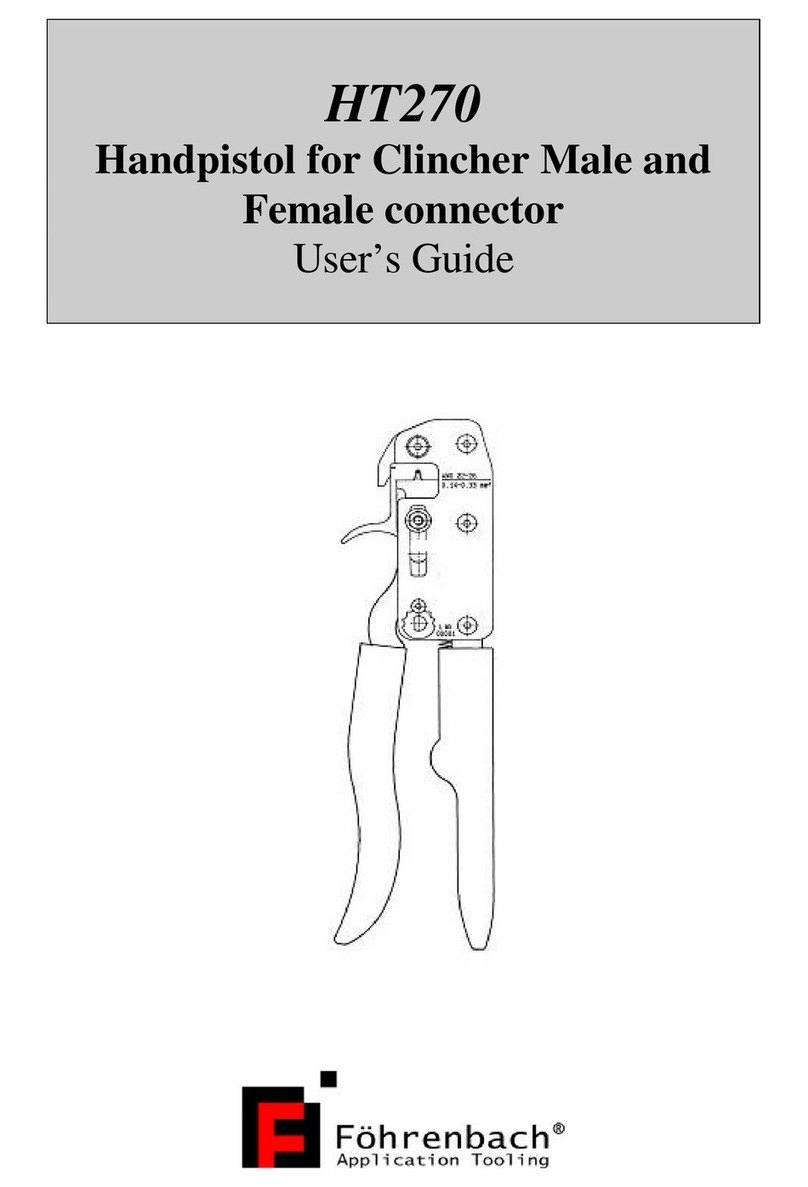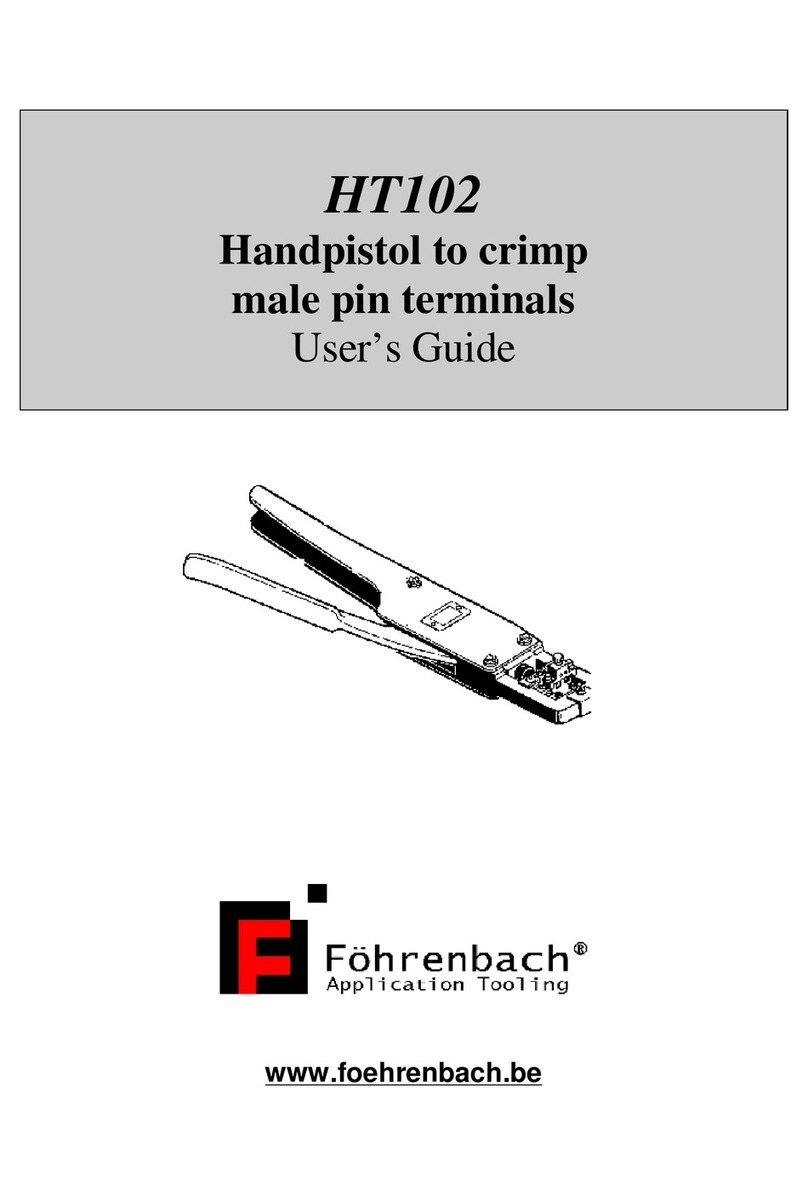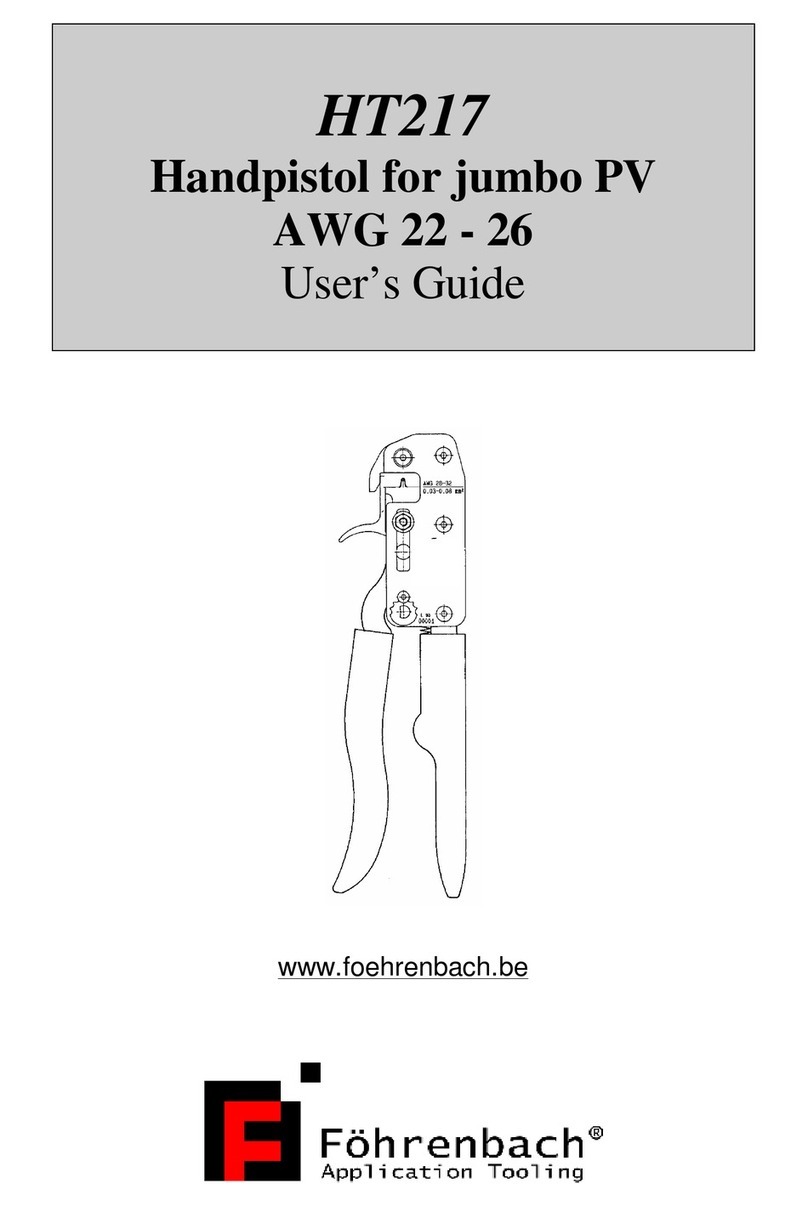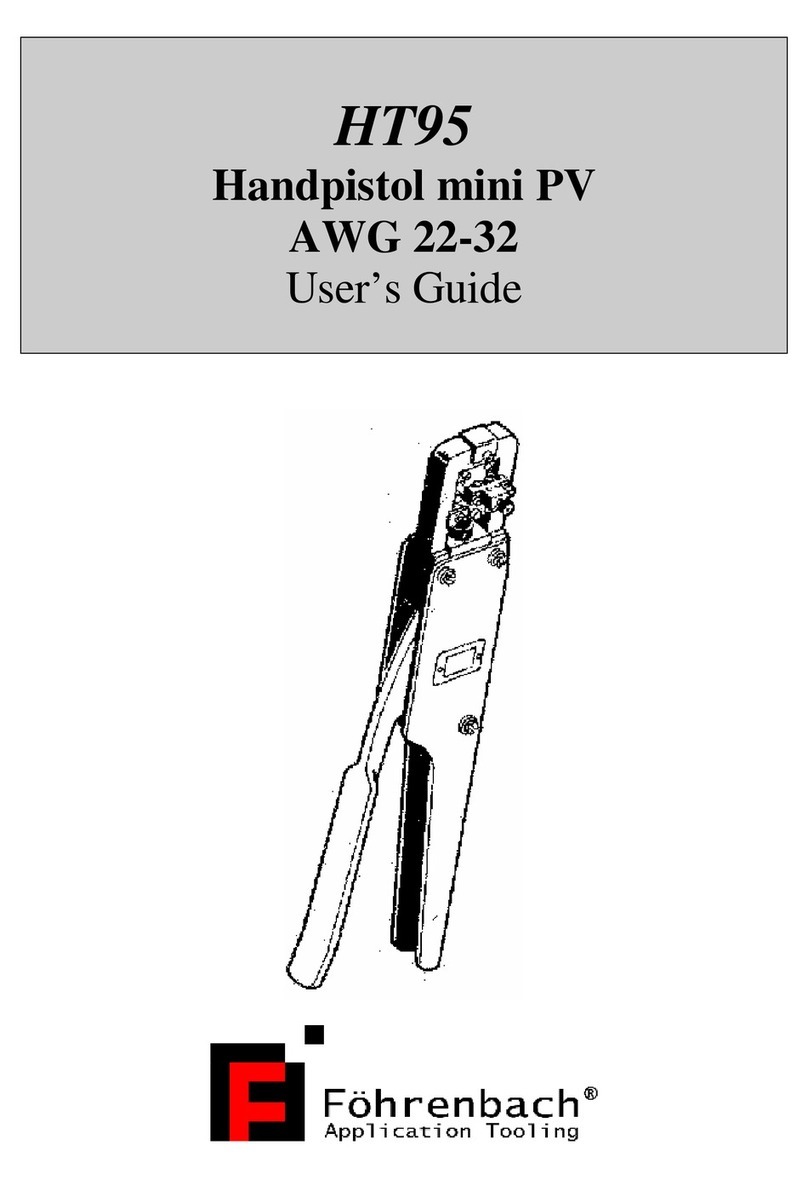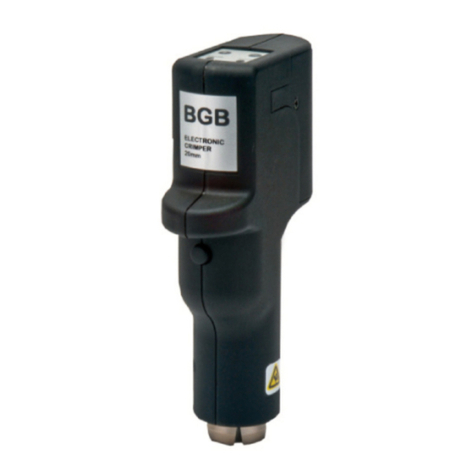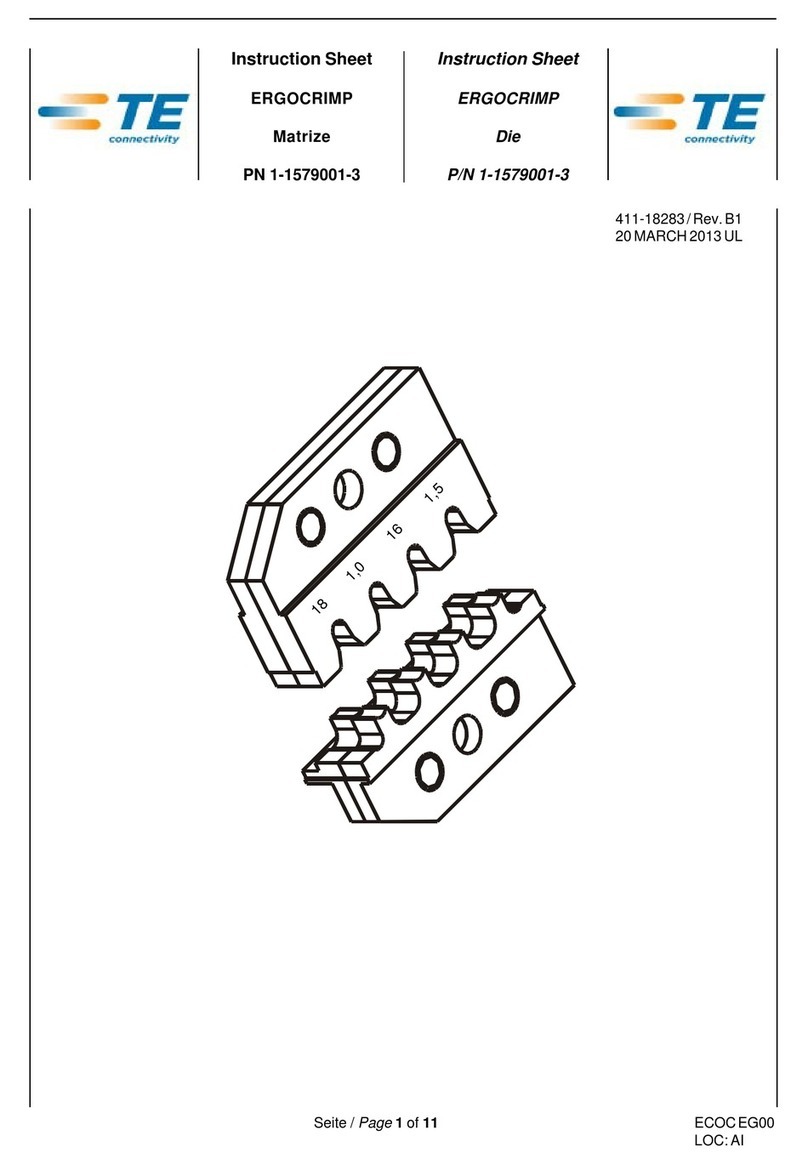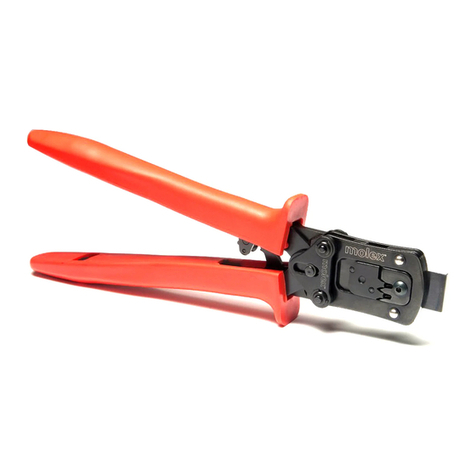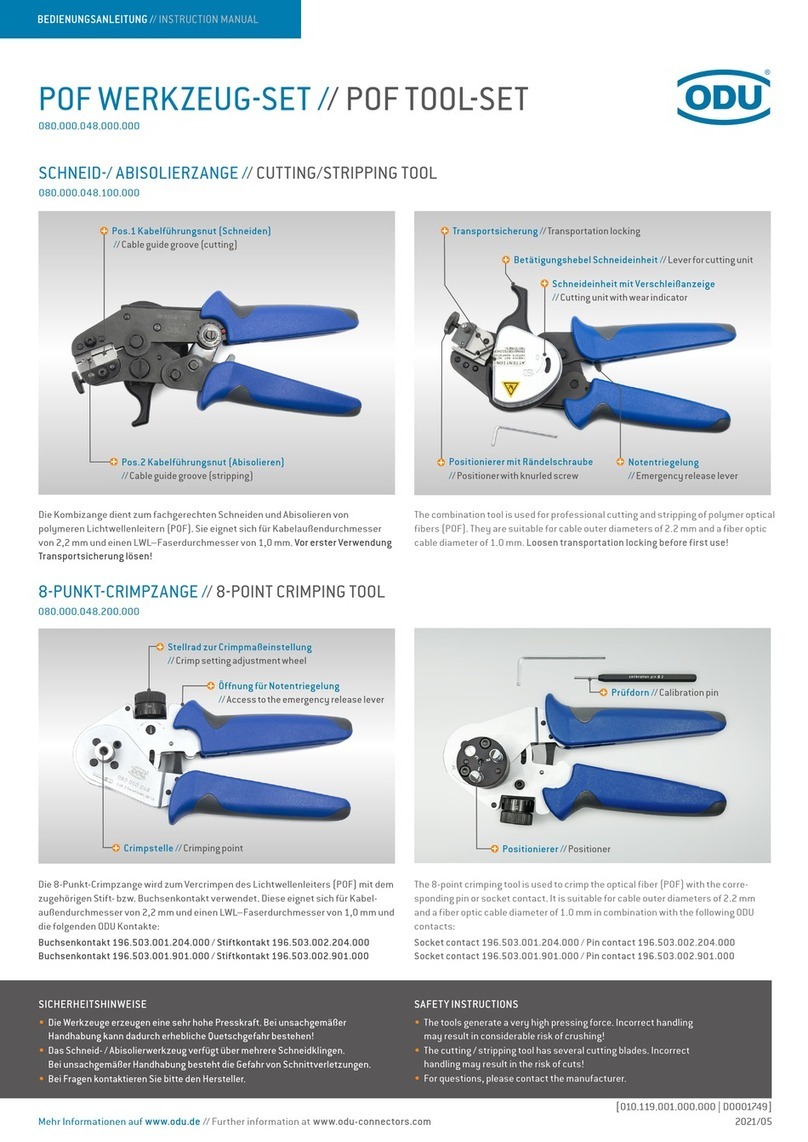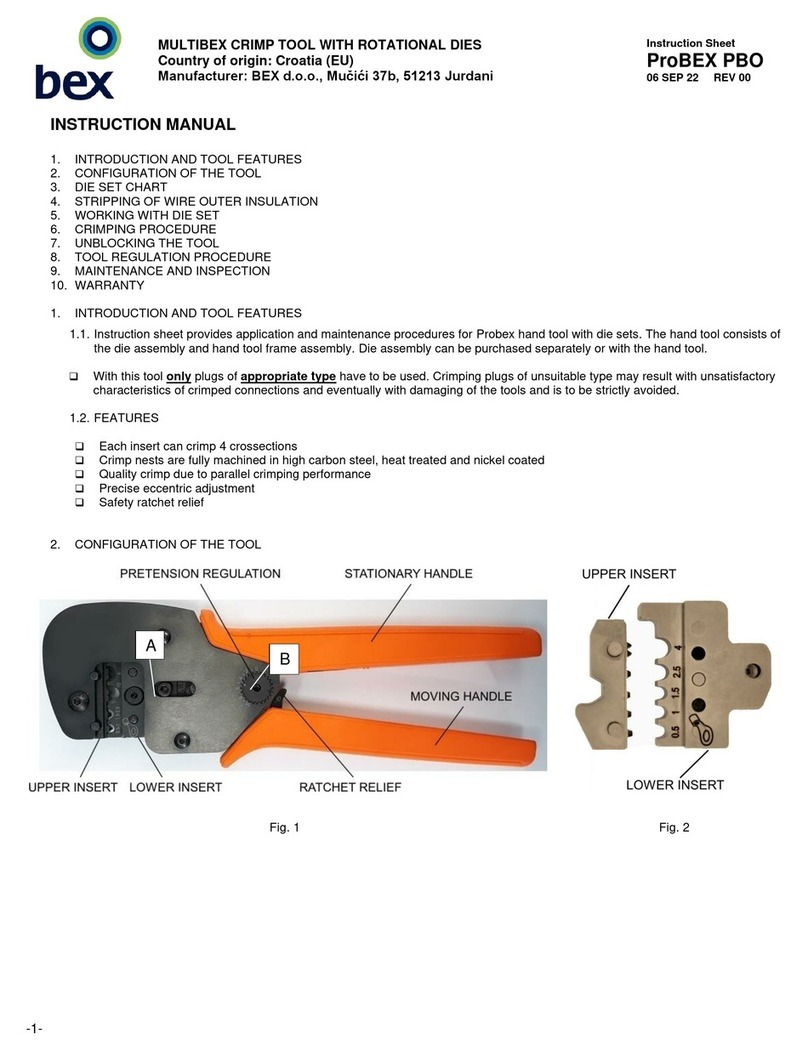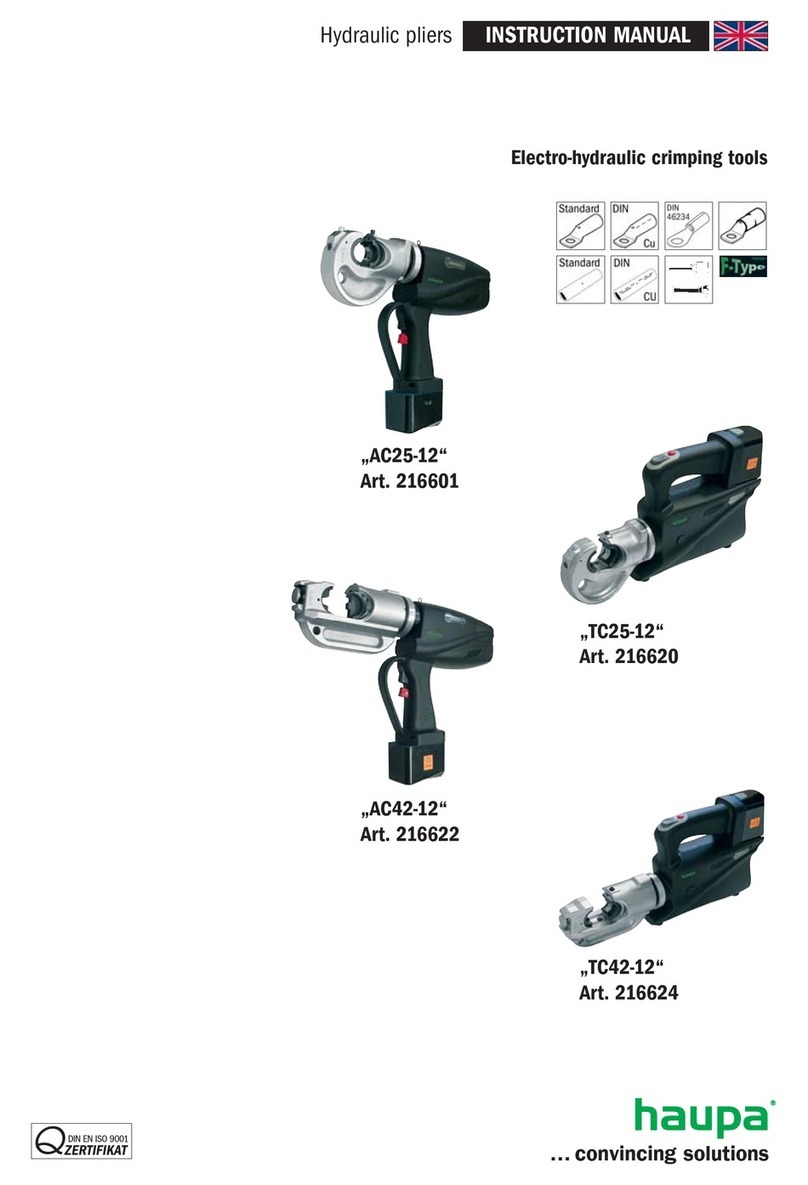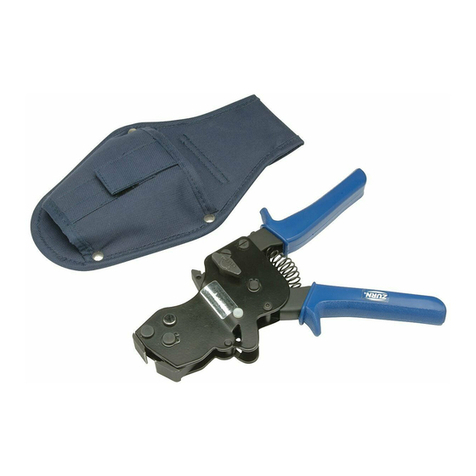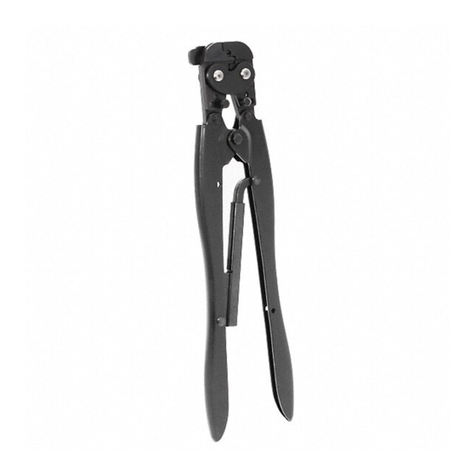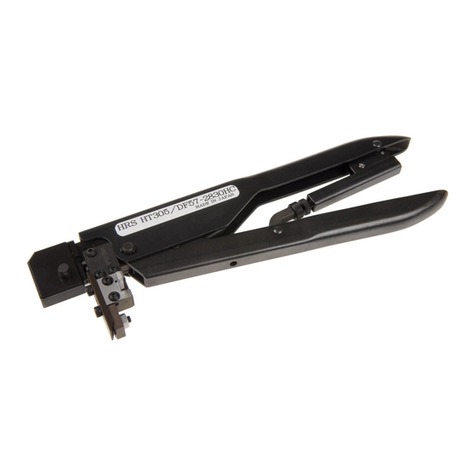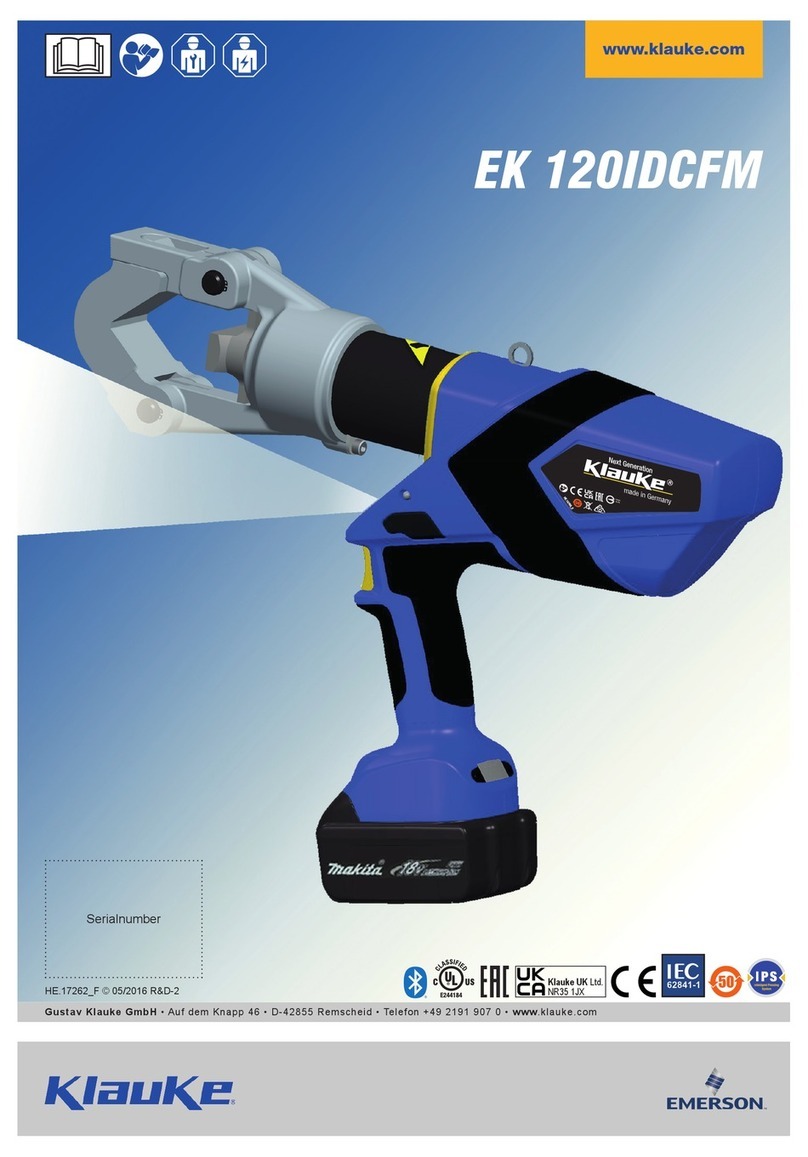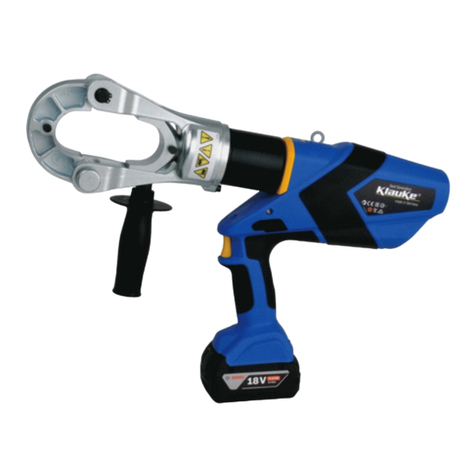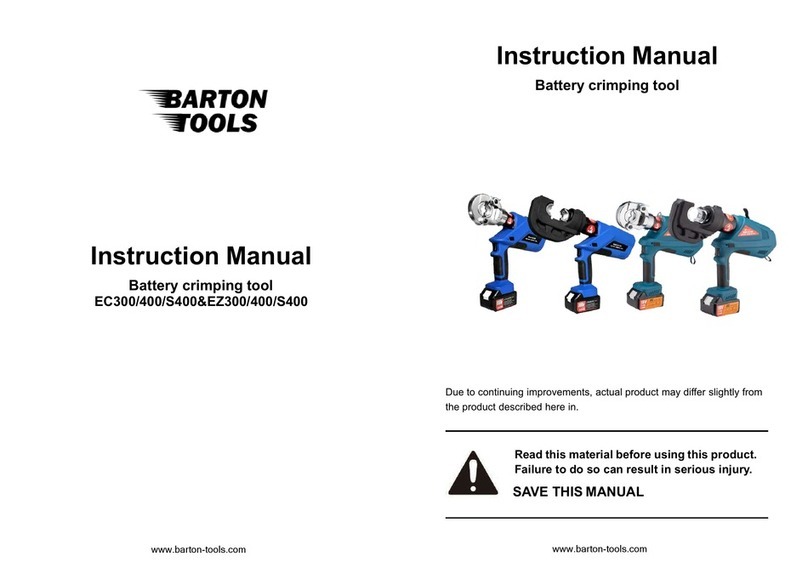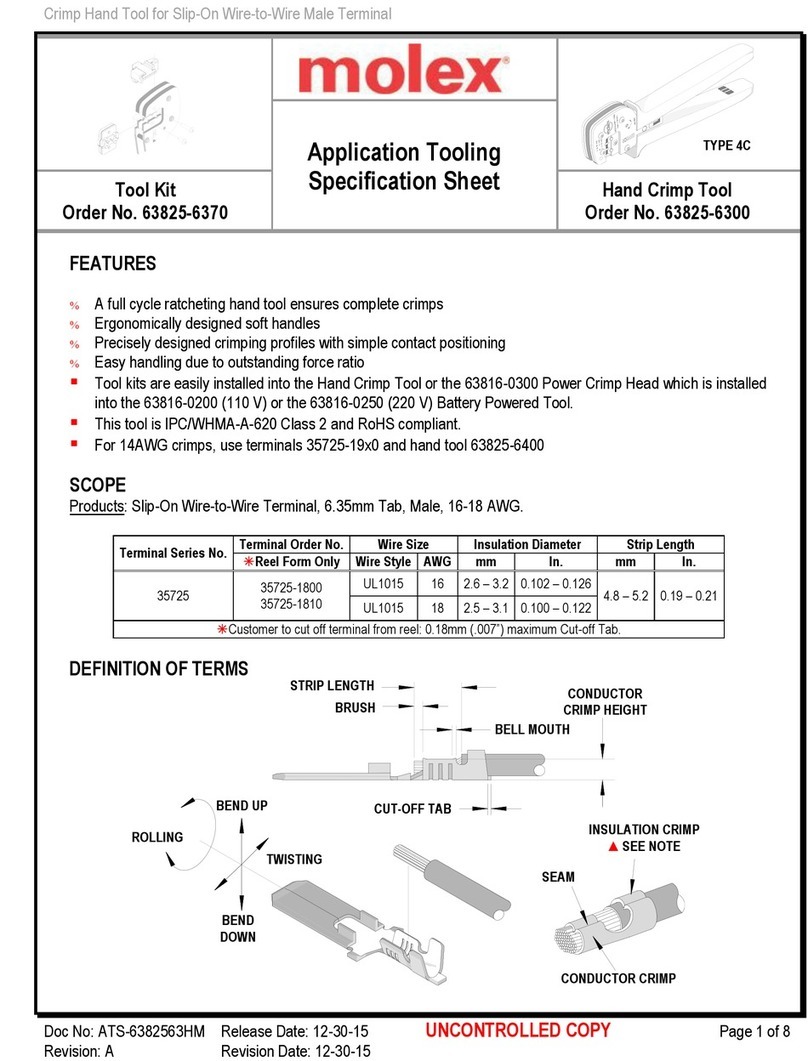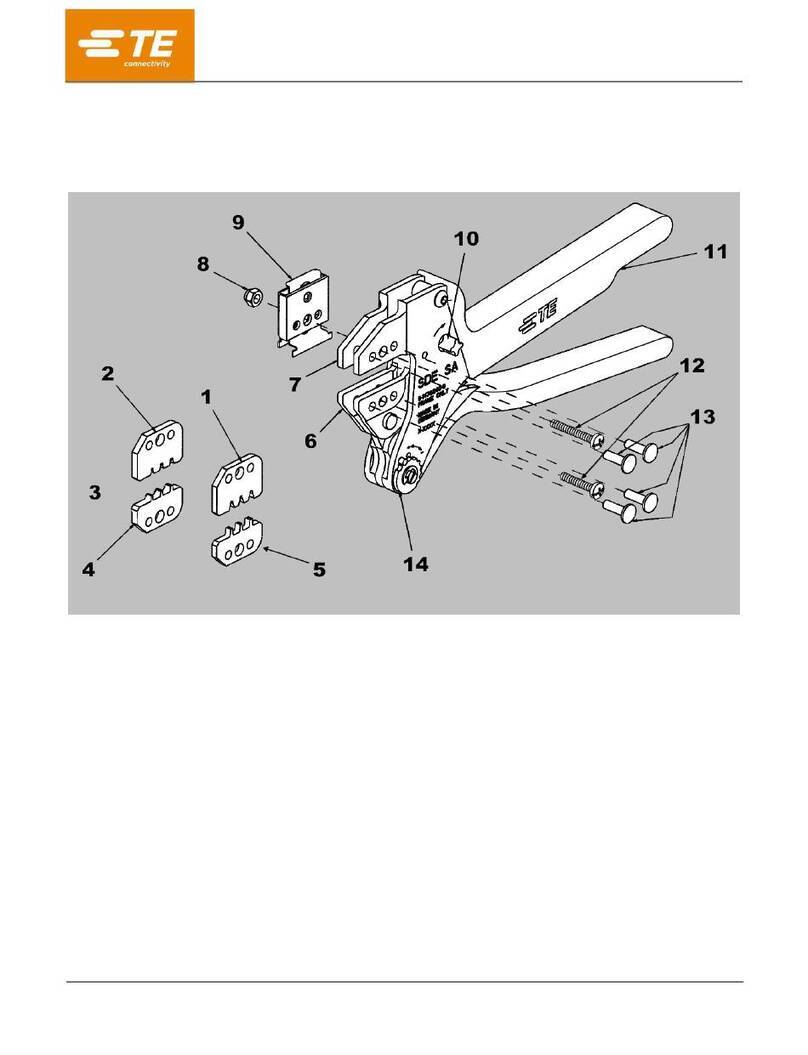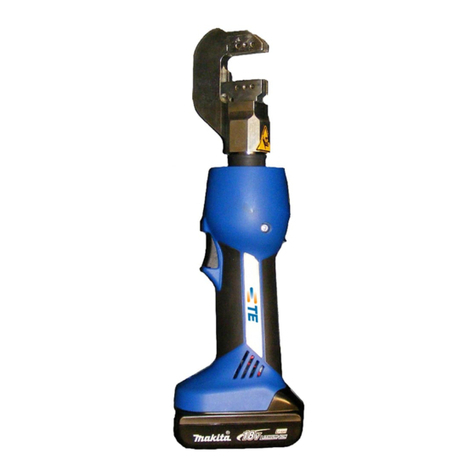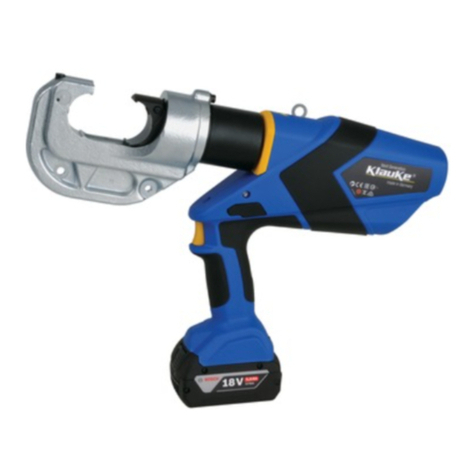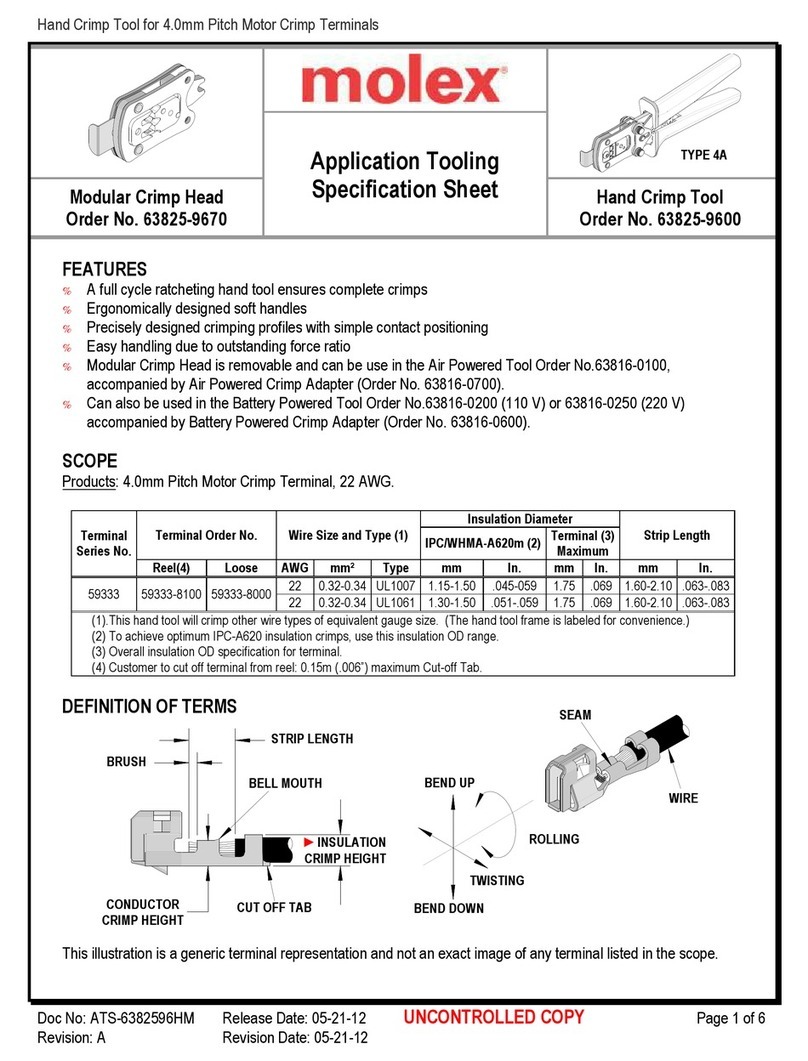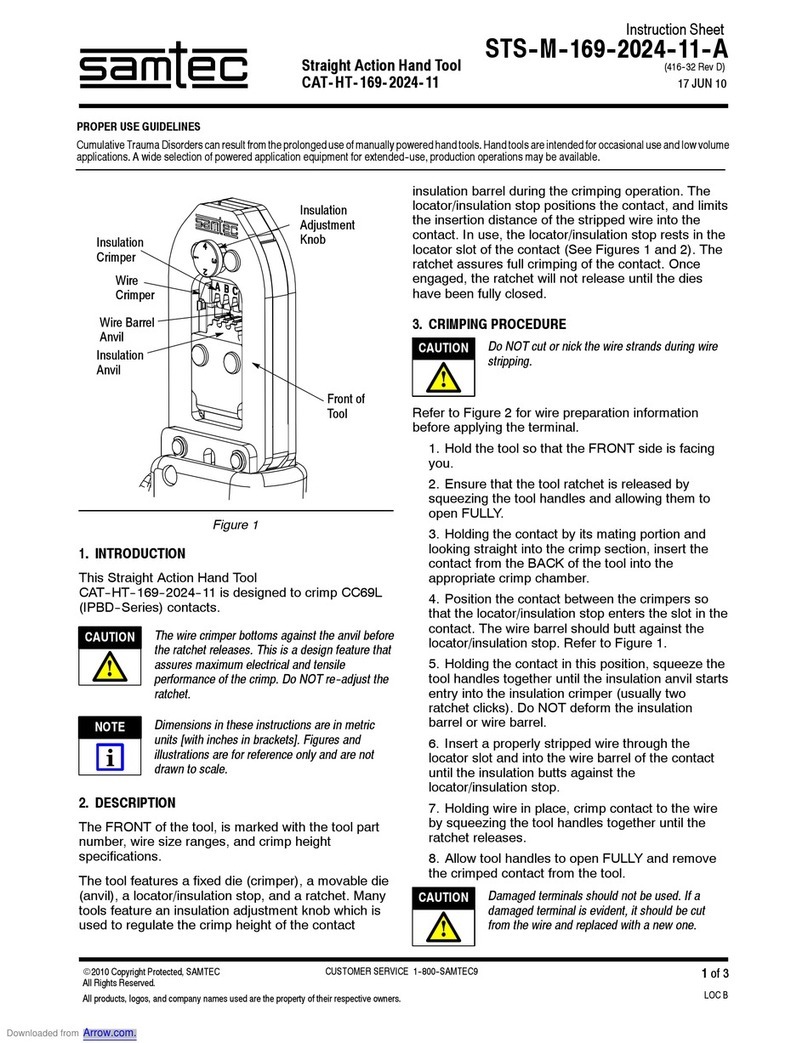Fohrenbach HT110 User manual

HT110
Handpistol to crimp
male pin terminals
User’s Guide
www.foehrenbach.be

Instruction manual HT110 www.foehrenbach.be
Date : Octobre 2007 Documentrev. : 4 Page : 2 / 13/
CONTENTS
1. INTRODUCTION ...........................................................................................................3
1.1. Hand Tool Function.....................................................................................................3
1.2. Physical Description....................................................................................................3
1.3. Principles of Operation................................................................................................3
1.4. Specifications..............................................................................................................4
2. OPERATION..................................................................................................................5
2.1. Operating Procedures.................................................................................................5
2.2. Terminal Inspection.....................................................................................................6
3. TROUBLESHOOTING...................................................................................................8
4. PARTS REPLACEMENT PROCEDURES.....................................................................9
4.1. Anvil Replacement ....................................................................................................9
4.2. Wire and Insulation Barrel Crimpers and Tonker Replacement
(see Figure 13) ..........................................................................................................11
5. ADJUSTMENT PROCEDURES.....................................................................................12
5.1. Crimp Height Adjustment ............................................................................................12
6. PARTS...........................................................................................................................14
6.1. Spare Parts ................................................................................................................14
6.2. Parts Ordering Information ........................................................................................14
6.3. Hand Tool Repair Policy ............................................................................................14

Instruction manual HT110 www.foehrenbach.be
Date : Octobre 2007 Documentrev. : 4 Page : 3 / 13/
1. INTRODUCTION
1.1Hand Tool Function
The HT-0110 is a manually operated hand tool designed for crimping loose piece (individual)
Crimp-to-Wire Male Pin terminals to wire sizes of 22-26 AWG.
1.2Physical Description
The major components that make up the HT-0110 are identified in Figure 1. These include a
frame, lever, tooling, tooling holders and a terminal holder. The heart of the hand tool is the
tooling. The tooling performs the crimping operation and is divided into top and bottom
component groups. The top group consists of those parts which remain stationary with the
frame. The bottom group contains those parts that move with the lever. The HT-0110 is
equipped with tooling for crimping two different ranges of wire sizes..
1.3Principles of Operation
The lever attaches to the lower tooling and provides the mechanical advantage to generate
the necessary crimping pressure. As the lever is closed, a ratchet mechanism engages to
prevent the lever from opening until the crimping cycle is complete.
When the lever is pulled closed, the lower tooling and terminal are pushed up against the
upper tooling. The crimp is formed between the wire and insulation barrel anvils and the wire
and insulation crimpers.
Once closed, the ratchet releases and allows a spring to pull the lever open

Instruction manual HT110 www.foehrenbach.be
Date : Octobre 2007 Documentrev. : 4 Page : 4 / 13/
1.4Specifications
When crimping the Male Pin to wires, the following parameters must be met.
- Wire Length Requirements:
•Minimum................. 19-05 mm (0.75 in.)
•Maximum................ As Required
- Insulation Diameters of Wires:
•Latch Housing and Discrete Applications .............................0.96-1.52 mm
(0.038-0.060 in.) Dia.
- Strip Length of Insulation:
Latch Housing and Discrete Applications .............................. 3.81-4.32 mm
(0.150-0.170 in.)
- Wire Barrel Crimp Height:
•Single Wire (22-26 AWG) Or Double Wires (26-28 AWG) .....0.76-0.81 mm
(0.030-0.032 in.)
- Insulation Barrel Crimp Height:
•Latch Housing and Discrete Applications .............................. 1.75 mm
(0.069 in.) Max. Dia.
- Male Pin Terminals:
•Loose Piece............................................................................22-26 AWG
NOTE
Loose piece terminals have different part numbers than reeled terminals
CAUTION
If the terminal and the tooling are not compatible, damage to the tooling could result. If you
wish to use a terminal with a part number other than the one that was ordered for the HT-
0110 check with your distributor to be sure that the new terminal number is compatible with
your hand tool.

Instruction manual HT110 www.foehrenbach.be
Date : Octobre 2007 Documentrev. : 4 Page : 5 / 13/
2. OPERATION
2.1Operating Procedures
WARNING
To prevent hand injury, keep fingers from between the upper and lower tooling and
from between the lever and handle when closing hand tool.
1. Hold the hand tool so that the lever is on the left. With your index finger, push and hold
the terminal holder in its forward position (see Figure 2).
NOTE
When inserting a terminal into the terminal holder you will notice a slight drag (interference)
on the terminal. The drag is caused by the spring ball plunger (see Figure 13 item no. 21)
applying downward pressure on the pin end of the terminal.
This downward pressure helps to orient and hold the terminal in the terminal holder until
crimped.
2. Insert the pin end of the terminal, with “U” shaped barrels
up, into the terminal holder and against the pin shoulder.
While holding the terminal against the shoulder, release
the terminal holder. This ensures that the terminal
remains in the proper position while moving over the
anvil.
Figure 2. Positioning Terminal for
Crimping

Instruction manual HT110 www.foehrenbach.be
Date : Octobre 2007 Documentrev. : 4 Page : 6 / 13/
3. While grasping the lever and the handle portion of the frame, insert a wire so that the end
of the insulation is centered between the wire barrel and the insulation barrel of the
terminal (see Figure 3). An alternate method is to position the end of the insulation
against the tonker (see Figure 13, item no. 2) which protrudes from between the crimpers
(3 & 4). Then close the hand tool lever completely. This will crimp the terminal to the
wire(s).
4. Release the lever to open the hand tool and remove the crimped terminal by lightly pulling
straight out on the wire.
CAUTION
The crimp height for this hand tool was factory adjusted. Any changes to this crimp
height adjustment could cause a defective crimp or damage to the tooling.
2.2Terminal Inspection
The crimped terminal should be inspected to ensure that the tooling is correctly aligned and
that the wire was correctly inserted. Make the following visual checks (see Figure 4).
NOTE
If inspection of the crimped terminal reveals any defects, the terminal has not been properly
crimped and should be discarded.
•Check that all wire strands were crimped within the wire barrel.
•Check that the end of the wire insulation lies between the insulation and the wire barrel.
•Check that the bellmouth(s) were formed correctly.
•Check that the wire barrel seam is even and tightly closed.
Figure 3. Crimping Terminal to Wire

Instruction manual HT110 www.foehrenbach.be
Date : Octobre 2007 Documentrev. : 4 Page : 7 / 13/
Next, obtain a crimp height micrometer and measure the areas of the terminal shown in
Figure 5. If the crimp heights do not meet the specifications listed in Section 1, Paragraph
2.4, refer to Section 5 for proper adjustment procedures.
Figure 4. Correctly Crimped Terminal
Figure 5. Measuring Crimp Height of
Terminal

Instruction manual HT110 www.foehrenbach.be
Date : Octobre 2007 Documentrev. : 4 Page : 8 / 13/
3. TROUBLESHOOTING
The troubleshooting information provided in the following chart will help isolate and identify
crimping problems.
Troubleshooting Chart, Male Pin Terminal
PROBLEM POSSIBLE CAUSE CORRECTIVE ACTION
Bellmouth(s) is deformed or
improperly positioned on wire
barrel.
Terminal is not properly
positioned in crimping area.
Insert terminal so its
shoulder is against the
terminal holder.
Reposition guide pins until
proper bellmouth(s) is
achieved.
Pin end of terminal is bent
down
Terminal is sticking in wire
barrel crimper.
Tooling is broken or
cracked.
Replace wire barrel crimper
as described in Section IV,
paragraph B.
The sides of the terminals wire
barrel are scored or scratched.
Wire barrel crimper is
defective.
Replace wire barrel crimper
as described in Section IV
paragraph B.
Flashings formed on the
bottom of the wire barrel are
unequal or abnormal.
Anvil is worn or broken Replace anvil as described
in Section IV, paragraph A.
Insulation bulges between wire
and insulation barrels.
Wire strip length is incorrect,
or wire was inserted too far
into the terminal.
Refer to Section I,
Paragraph D (specifications)
for strip length requirements.
Insulation bulges around
insulation barrel
Wire or insulation diameter
is incorrect for the terminal
being used.
Refer to section I, paragraph
D (specifications) for correct
insulation diameter
requirements.

Instruction manual HT110 www.foehrenbach.be
Date : Octobre 2007 Documentrev. : 4 Page : 9 / 13/
4. ARTS REPLACEMENT PROCEDURES
4.1Anvil Replacement
Replace anvils when they show excessive wear or become cracked or chipped.
Removal
1. Remove the cap screw securing the anvil holder assembly to the hand tool (see Figure 6)
and then remove the anvil holder assembly.
2. Remove the cap screw and defective anvil(s) from the anvil holder (see Figure 8).
Installation
NOTE
When replacing the anvils, be sure that the part number for the new anvil(s) is the same as
the one being replaced.
1. Loosely install the new anvils to the anvil holder with the attaching cap screw (See Figure
8).
2. Reinstall the anvil holder onto the hand tool and tighten the attaching cap screw.
CAUTION

Instruction manual HT110 www.foehrenbach.be
Date : Octobre 2007 Documentrev. : 4 Page : 10 / 13/
To prevent the anvils from being damaged during alignment, place a piece of paper over
the anvils.
3. Cut out two strips of paper. Then fold the strips in half and place them over the anvils (see
Figure 9).
4. Slowly close the hand tool lever completely. This will align the anvils to the crimpers. Then
tighten the anvil cap screw and release the lever. Next, remove the paper from the anvils.
5. Reinstall the terminal holder to the anvil holder. Make sure that the flats on the end of the
terminal holder guide pins face the setscrews in the anvil holder. Then tighten the anvil
holder set screws.
6. Crimp a terminal to the proper size wire. Then inspect the terminal as described in section
II, paragraph B.
4.2Wire and Insulation Barrel Crimpers and Tonker Replacement (see Figure 13)
Removal
1. Loosen, but do not remove at this time, the two cap screws (7) that secure the crimpers to
the crimper holder (1).
2. Remove the cap screw (9) from the crimper holder (1).
Then remove the spring retainer (8) and the crimper holder (1) with crimpers attached.
3. Remove the two tonker springs (5) and the two spring guides (6) from the hand tool
frame. This can be accomplished by tilting the hand tool down.
4. Remove the two cap screws (7) that secure the crimpers to the crimper holder (1).
5. Remove the crimpers (3 and 4) and tonkers (2) from the crimper holder (1).
6. Remove the damaged crimper(s) (3) or (4). The top crimper is the wire barrel crimper
(4).
Installation
NOTE

Instruction manual HT110 www.foehrenbach.be
Date : Octobre 2007 Documentrev. : 4 Page : 11 / 13/
When replacing tooling, always be sure that the part number of the new part is the same
number that is on the old part that was removed
7. Place the insulation crimper (3) onto the flat side of the crimper holder (1). Place the wire
barrel crimper (4) on the insulation crimper (3) and loosely install the two attaching cap
screws.
8. Insert tonkers (2), with the top tabs facing outwards, into the slots between the wire and
insulation crimpers.
9. Place and hold the crimper assembly into the hand tool with crimper holder (1) on the
same side as the anvil holder (11).
Make sure that the tonkers (2) go into the holes in the top of the hand tool frame.
10.Place spring guides (6) into the holes in top of the hand tool frame, then insert the springs
(5) into the holes so that the springs slip over the body of the spring guides.
11.Place spring retainer (8) over tonker springs (5). Make sure springs are compressed, then
loosely attach the spring retainer (8) and the crimper holder (1) to the hand tool with the
attaching cap screw (9).
12.To align the tooling, close hand tool completely and hold it in it.s closed position. Tighten
the two cap screws (7) to secure the crimpers to their holder. Then tighten the cap screw
(9), which secures the crimper holder to the hand tool frame.
13.Crimp a terminal to a proper-size wire and inspect the terminal as described in Section II,
paragraph B.
5. ADJUSTMENT PROCEDURES
5.1 Crimp Height Adjustment
1. Remove the cap screw securing the anvil holder assembly to the hand tool (see Figure
10). Then
remove the anvil holder assembly.
2. Insert a 3/32-inch Allen wrench into the hole in the adjustable tool holder and into the
socket head
setscrew (see Figure 11). Turn the setscrew ¼ turn counterclockwise to unlock the
adjusting collar.

Instruction manual HT110 www.foehrenbach.be
Date : Octobre 2007 Documentrev. : 4 Page : 12 / 13/
3. Close the hand tool lever one click to gain access to the holes in the side of the adjusting
collar. Next, insert a pin approximately 1/16-inch in diameter, into one of the holes in the
collar (see Figure 12). Then rotate the collar about 5 degrees counterclockwise to
increase crimp height or clockwise to decrease crimp height.
4. Reinstall the anvil holder assembly onto the hand tool and tighten the attaching cap
screw.
5. Crimp a terminal to the proper size wire and check the wire barrel crimp height of the
crimped terminal. If crimp height is not as specified, remove the anvil holder assembly
and turn the adjusting collar an additional 5 degrees. Then reinstall the anvil holder
assembly and again check the crimp height. Continue adjusting the crimp height in this
manner until the proper crimp height is achieved.
6. Remove the anvil holder assembly and tighten the setscrew clockwise in the adjustable
tool holder. Then reinstall the anvil holder assembly and tighten the attaching cap
screw.

Instruction manual HT110 www.foehrenbach.be
Date : Octobre 2007 Documentrev. : 4 Page : 13 / 13/
6. PARTS
6.1 Spare Parts
These are parts that Föhrenbach Application Tooling considers practical for the user to stock
for replacement. Recommended spare parts for the hand tool are specified in bold type in the
parts list for Figure 13.
6.2 Parts Ordering Information
To obtain replacement parts, contact Föhrenbach Application Tooling.
6.3 Hand Tool Repair Policy
Föhrenbach Application Tooling charges a standard rate to repair any hand tool not under
warranty. Föhrenbach Application Tooling will repair the hand tool and return it to you by the
fastest means possible.
The technical data in this publication has been carefully checked and assembled. No liability from inaccuracies or errors is assumed. The right to change or
improve this document without notice is reserved.
Table of contents
Other Fohrenbach Crimping Tools manuals
